One of the things that I’ve been collecting for years, are the annual books published by first the ACBL and later the WBF reporting on that year’s World Championships. Obviously, the goal is to get the series complete. 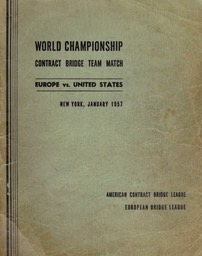 Recently, I got a bit closer to that goal when I found a copy of the 1957 book. That got me 1 step closer, I’m now only looking for the 1951, 1953 and 1964 books, and perhaps 1958 as my copy is a reprint of the original. And of course, 2016, but that one won’t be published until November.
Recently, I got a bit closer to that goal when I found a copy of the 1957 book. That got me 1 step closer, I’m now only looking for the 1951, 1953 and 1964 books, and perhaps 1958 as my copy is a reprint of the original. And of course, 2016, but that one won’t be published until November.
Anyway, now that I have the 1957, time to actually read it. Nobody knew it back then, but the 1957 event marked the start of an era. The Italian team won the first of their 10 consecutive titles (1957-1969). Today, and in one of the next episodes of this blog, we look back at the event. Back then, the Bermuda Bowl was a simple match between representatives of the Europe (the winner of the 1956 European champion) and the US (the winner of their summer nationals).
The event was played in New York, January 6-11, 1957, 224 boards, split over 12 or 14 board sessions, complete with vuegraph and a fishbowl, a soundproof room where the audience could see the players. Teams-of-four, obviously. Imp’s had not been introduced to the western hemisphere, so scoring was done by total points.Compared to today’s imp's, that makes overtricks and undoubled undertricks even less important than they are today. Honnors were still scored, if you held 4 aces and ended up playing in NT, or 4 out of the 5 honnors in the trump suit, you’d score a 100 point bonus. Of course, this has hardly any effect on the score, as both sides will usually score the same bonus. All hands are reported in the book, which is good. What is also great about the book, is that all plays are described trick by trick. Not so good is that there is no explanation of the bidding other than brief system notes at the start. 60 years later, that requires some guesswork from an analist.
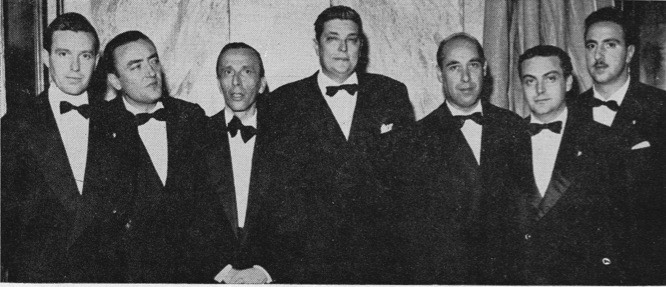
The Italian Team (left to right): Pietro Forquet, Massimo D’Alelio, Eugenio Chiaradia, Carl Alberto Perroux (NPC), Walter Avarelli, Guglielmo Siniscalco, Giorgio Belladonna.
A word about players and systems. The Italians fielded 3 fixed pairs (Forquet-Siniscalco, Avarelli-Belladonna, and Chiradia-d’Alelio), with 2 pairs playing early versions of the soon to be famous Italian club systems: Neapolitean Club (1♣ strong, 17+, with control showing responses, all other opening bids natural, limited and canape style) for Forquet and Siniscalco, Roman Club (1♣ either a weak NT, a very strong NT or a gameforcing hand, other suit bids again natural and canape style, specialized 2 bids to show 2- and 3-suited hands) for Belleadonna and Avarelli. Canape style means that the second suit bid is longer than the first suit bid, i.e. 1♠-1NT-2♦ shows 4♠ and 5♦, and not the other way around as in natural bidding. The third pair used natual methods similar to the Americans.
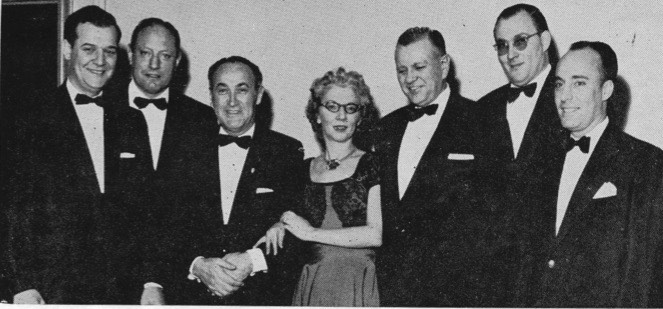
The US Team (left to right): Billy Season, Harold Ogust, Charles Goren, Helen Sobel, RL Miles (npc), Peter Levintritt and Boris Koytchou.
The Americans followed a different approach, they fielded 6 players (Mrs. Sobel, Goren, Ogust, Leventritt, Koytchou, Seamon) and one general system, then selected partnerships on a per-session basis. Over the match, at least 9 of the 15 possible pairings played some number of boards. The system was basically a strong NT (16-18), 4 card suits and a strong 2♣, with some small variations for specific pairings.
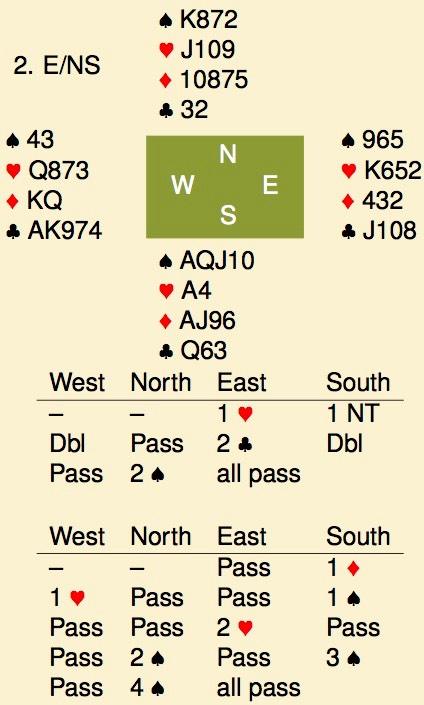
So, time to look at some of the hands and in particular how the game evolved over the last 60 years. The first interesting swing occurred on board 2, when Koytchou, for the US, opened 1♥ on this holding. Yes, an outright psyche, 1st seat, and not something you’d see in 2017 at the start of an important match. The auction continued as shown and the full hand shows that partner must have seen these psyches before. Perfectly acceptable in 1957 but not in 2017 where this would be considered a fielded psyche and thus illegal method. The psyche didn’t do much damage to either side, as the normal 2♠ contract was reached for 8 tricks, losing a heart, 2 diamonds and 2 clubs.
The replay was also interesting.
South opened 1♦, even though he was playing 16-18 1NT’s with the additional requirement of something in every suit. That seems to have been met here, but still 1♦ was opened. 3 is interesting, first you pass 2♥, then when partner comes alive after having passed twice before, you suddenly invite game. Partner, with about a king over minimum, accepted. Down 2, again losing 2 diamonds and 3 round suit tricks. 310 to Italy.
And if you think that this was +110 and +200 adding up to +310, your are wrong, it was +210 and +100. Remember that honnors were scored, so south got a 100 point bonus at both tables.
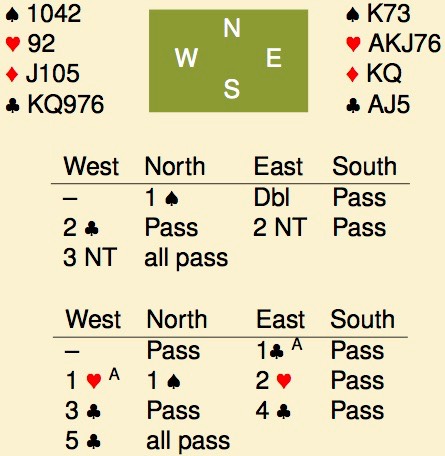
The first game swing occured on board 9. The US east played 3NT after north had bid spades. South led the ♠Q, 2, 8, 3, and the ♠9, 4, 5, K. Over to you.
At a first glance, there doesn’t seem to be much in the play. You have 8 tricks, setting up diamonds won’t work, so all you can do is take a heart finesse. You can postpone the decision a bit by playing 5 rounds of club first, if you do so, you’ll find that south started with 2 spades and 4 clubs, and north with 5 spades and 1 club, or both players started with 6 black cards and thus 7 red ones. North discarded 3 diamonds and a heart on the clubs. South discarded a diamond. Is that helpful? Well, yes, it strongly suggests that the ♥Q is offside, as north would not discard a heart from ♥Qxx. East then decided to play south for ♥Qx by cashing the ♥AK. That didn’t work, and he finished down 1. There is a flaw in this argument: north, so-far, has only shown 5 points, while he did open the bidding, give him the ♦A and he still doesn’t have his bid. Also, he was forced to discard something on the fifth club, and could have well decided to play his partner for the ♥J. All in all, I don’t think that this was the right line of play.
In the replay, the Italians bid 5♣ after the preempted themselves: 1♣ showed 17 or more, 1♥ showed just 1 king and a few points, not a suit. By the time everybody had bid his suit, east had to decide to support partner’s clubs or bid NT. He picked the former and found partner with good clubs, making 5♣ a reasonable contract. On a spade lead, with hearts 3-3, declarer came to 11 tricks.
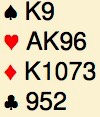
Two style differences showed up on board 16 and 17. First board 16, as north you pick up this collection and your right hand opponent opens 1♦. Your call?
The consensus amongst the US experts of the time, seemed to be that you had to double any 1 level opener with opening bid strength yourself, and that an overcall showed less strength. What if partner bid a suit that you didn’t have after a double? Well, that is something to worry about later. The Italians followed a more modern approach, where the take-out double promises support for the unbid suits and an overcall can be stronger. Thus, it is not surprising that Belladonna decided to bid 1♥ where Ogust doubled. The hand itself isn’t that interesting, the opponents reached a partial.
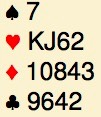
Another style difference on board 17: over the match, there seems to be a tendency of the US experts to lead singletons and unsupported aces, hoping for a ruff or to find singleton or useful honnor opposite. The Italians looked more for strength. With this in mind, decide on your opening lead against 6♣. The auction suggests that dummy will come down with 6♠-4♣ and something in the 13-16 range, declarer will have 4♦-4♣ in the minors, a strong hand and a heart control.
Following the local doctrine, Ogust for the US led the ♠7, whereas Belladonna tried a small heart. The result? Here is the full hand.
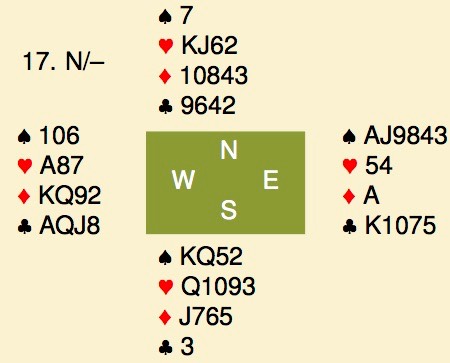
Forquet for Italy won the ♠A and immediately returned a small spade, no doubt trying to set up the suit. South went up with the ♠K and continued with a spade. Fortunately, declarer had a plan B: a cross-ruff. In trick 3, south returned a spade (not that it matters, any other just chances the order of the tricks) ruffed with the ♣J. Diamond to the ♦A, heart to the ace, ♦K for a heart discard, ♦Q and now declarer could ruff 2 red suit cards with the ♣75 and 2 more spades with the ♣AQ. Finally, he scored the ♣K10 for his last 2 tricks. Well played, by the way.
In the other room, the heart lead forced declarer to win, play a diamond to the ace, a club back and a diamond to pitch a heart. With both spades offside and the trumps 4-1, the contract could no longer be made.
Both style differences will come back later on in the review of this event, for now we close with a score of 870 in favor of the Italians (40-59 in today’s imp’s) after 20 boards.
To be continued.
